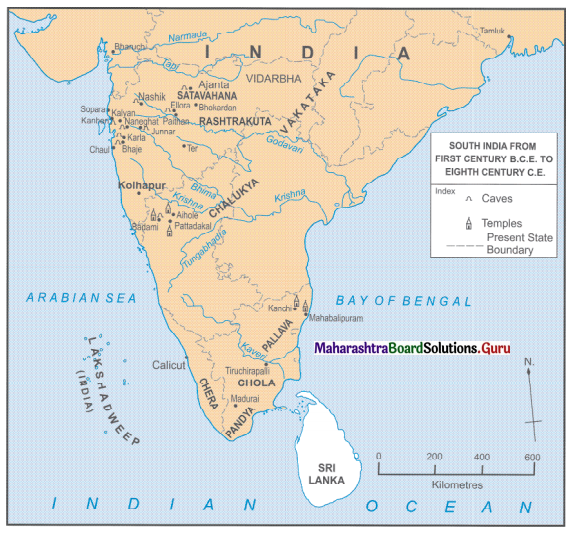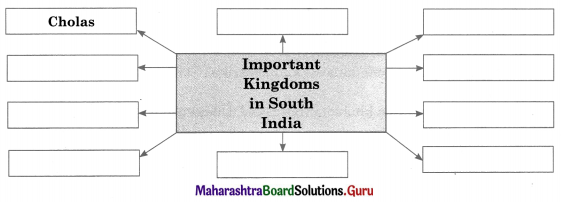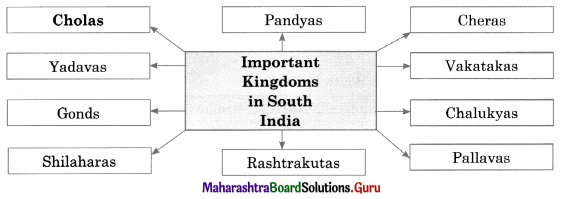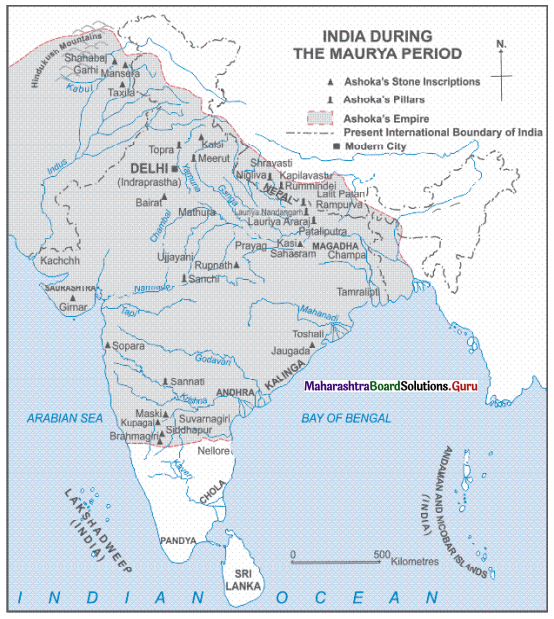Balbharti Maharashtra State Board Class 11 History Important Questions Chapter 6 Second Urbanisation in India Important Questions and Answers.
Maharashtra State Board 11th History Important Questions Chapter 6 Second Urbanisation in India
1A. Choose the correct alternative and write complete sentences.
Question 1.
___________ is identified with Nadura in Buldhana district.
(a) Potana
(b) Vidarbha
(c) Bhoja
(d) Dandaka
Answer:
(a) Potana
Question 2.
___________ was the son of Rishabhnath, the first Jain Tirthankara.
(a) Mahavir
(b) Bahubali
(c) Gautama Buddha
(d) Andhakraja
Answer:
(b) Bahubali

Question 3.
The Jataka story known as ___________ Jataka gives us the list of kings who ruled the State of Videha.
(a) Assaka
(b) Chulla Kalinga
(c) Nimi
(d) Mahaparinibbansutta
Answer:
(c) Nimi
Question 4.
The city of ___________ was the capital of Anga.
(a) Varanasi
(b) Shravasti
(c) Rajagriha
(d) Champa
Answer:
(d) Champa
Question 5.
___________ was the 24th Tirthankara.
(a) Vardhaman Mahavir
(b) Parshavanath
(c) Rishabha
(d) Bahubali
Answer:
(a) Vardhaman Mahavir
Question 6.
___________ was known as Tathagatha or Shakyamuni.
(a) Vardhaman Mahavir
(b) Gautam Buddha
(c) Andhakraja
(d) Emperor Ashoka
Answer:
(b) Gautama Buddha

Question 7.
___________ was the capital of Asmaka.
(a) Potali
(b) Varanasi
(c) Vaishali
(d) Mathura
Answer:
(a) Potali
Question 8.
The city of Champa was the capital of ___________
(a) Kasi
(b) Anga
(c) Kosala
(d) Magadha
Answer:
(b) Anga
1B. Find the incorrect pair from set B and write the correct ones.
Question 1.
| Set ‘A’ |
Set ‘B’ |
| (a) Jataka story giving a list of kings who ruled Videha |
Nimi Jataka |
| (b) Jataka story giving the name of the king who ruled Kasi |
Assaka Jataka |
| (c) Jataka story describing the battle between king Assaka and the Kalinga king |
Chulla Kalinga Jataka |
| (d) Buddhist text that mentions that the king of Kasi had defeated Kosala |
Mahaparinibbansutta |
Answer:
Buddhist text that mentions that the king of Kasi had defeated Kosala – Mahavagga
Question 2.
| Set ‘A’ |
Set ‘B’ |
| (a) Anga |
Champa |
| (b) Magadha |
Viratnagar |
| (c) Vrujji/Vajji |
Vaishali |
| (d) Malla/Malava |
Kushinara/Kushinagara |
Answer:
Magadha – Girivraja/Rajgriha
Question 3.
| Set ‘A’ |
Set ‘B’ |
| (a) Kuru |
Indraprastha/Indrapattan |
| (b) Uttar Panchala |
Ahichchhatra |
| (c) Dakshina Panchala |
Taxila |
| (d) Matsya |
Viratnagar |
Answer:
Dakshina Panchala – Kampilya

1C. Find the odd one out.
Question 1.
Buddha, Tathagatha, Shakyamuni, Vardhamana Mahavira
Answer:
Vardhamana Mahavira
Question 2.
Nimi Jataka, Assaka Jataka, Chulla Kalinga Jataka, Mahavagga
Answer:
Mahavagga
Question 3.
Swarajya, Bhaujya, Vairajya, Rajasuya
Answer:
Rajasuya
Question 4.
Aspasioi, Assakenoi, Astakenoi, Andhakraja.
Answer:
Andhakraja
Question 5.
Vidarbha, Paudanya, Bhoja, Dandaka.
Answer:
Paudanya
Question 6.
Purohita, Senani, Rajya, Amatya.
Answer:
Rajya
Question 7.
Svaarajya, Bhaujya, Vairajya, Gramani.
Answer:
Gramani

Question 8.
Ashvamedha, Maharajya, Saamrajya, Parmeshthya.
Answer:
Ashvamedha
2A. Write the names of historical places, persons, and events.
Question 1.
Term mentioned in Panini’s Ashtadhyayi meaning Avanti and Ashmak.
Answer:
Avantyashmak
Question 2.
Region on the bank of the Godavari
Answer:
Andhakratta
Question 3.
Capital of Kosala
Answer:
Shravasti
Question 4.
Statue of Bahubali in the Hassan district of Karnataka
Answer:
Shravanabelagola
Question 5.
Disciple of Gautama Buddha
Answer:
King Prasenjit
Question 6.
The play was written by Bhasa
Answer:
Swapnavasavadatta
Question 7.
Contemporary of Gautama Buddha
Answer:
Bimbisara

Question 8.
Capital of Gandhara
Answer:
Taxila
Question 9.
Chief of a guild of artisans
Answer:
Jyeshthaka
Question 10.
Founder of Buddhism
Answer:
Gautam Buddha
2B. Choose the correct reason and complete the sentence.
Question 1.
The core principle of Vardhamana Mahavir’s philosophy is ___________
(a) Vedanta
(b) Mimamsa
(c) Charavaka
(d) Pluralism (Anekantavada)
Answer:
(d) Pluralism (Anekantavada)
Question 2.
Kamboja mahajanapada is mentioned in the ancient literature along with ___________
(a) Kosala
(b) Magadha
(c) Anga
(d) Gandhara
Answer:
(d) Gandhara
Question 3.
It seems that the king of Assaka was known as ‘Andhakraja’ during ___________
(a) Gautama Buddha’s times
(b) Vardhaman Mahavir’s times
(c) Second Urbanisation
(d) Mahajanpada
Answer:
(a) Gautama Buddha’s times

3. Observe the map on page 39 of your textbook and answer the following questions based on it.
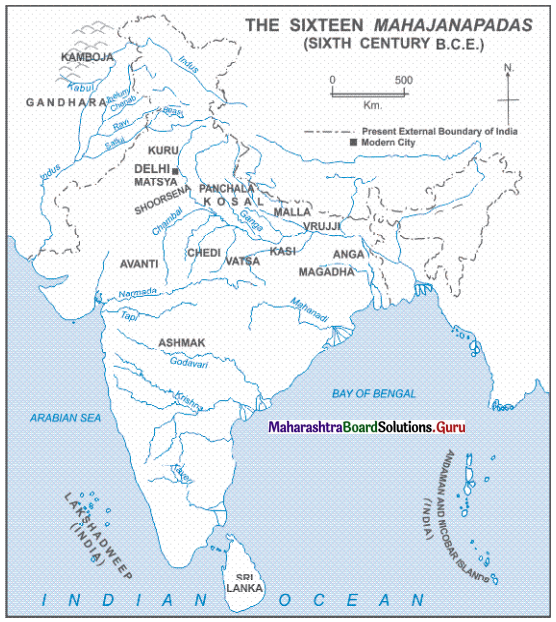
Question 1.
Name the sixteen Mahajanapadas shown on the map.
Answer:
The sixteen Mahajanapadas shown on the map are Kamboja, Ghnadhara, Kuru, Surasena, Pachala, Kosala, Malla, Vrujji, Anga, Magadha, Kasi, Vatsa, Chedi, Avanti, Shoorasena, and Ashmaka.
Question 2.
Name the islands in the Bay of Bengal.
Answer:
The islands in the Bay of Bengal are Andaman and Nicobar Islands.
Question 3.
Name the ocean found at the tip of India.
Answer:
The Ocean found at the tip of India is the Indian Ocean.
Question 4.
Name the sea at the west of India.
Answer:
The Sea at the west of India is the Arabian Sea.
Question 5.
Name the modern city shown on a map.
Answer:
The modern city shown on the map is Delhi.

4. Complete the concept maps.
Question 1.

Answer:

Question 2.

Answer:

Question 3.

Answer:


5. Explain the following concepts.
Question 1.
Guilds (Shrenis)
Answer:
- Along with agriculture and animal husbandry, trade and systematic management, and organisation of the trade are also essential factors for the prosperity of a state.
- The guilds of the merchants and the artisans played a great role in the growth of the mahajanapadas into wealthy states.
- These guilds had their own way of organisation and functioning.
- Guilds had their own, strict rules. Hence, they had a stringent structure.
- This stringent structure is perceived as one of the main reasons for the rise of the caste system.
6. State your opinion.
Question 1.
The Charavaka/Lokayat school denies the existence of ‘God’.
Answer:
- One of the ancient Indian schools of thought was the Charavaka or the Lokayat school of thought.
- This school denies the existence of God.
- It opposes the authority of Vedas (Vedapramanya) and the notions of the existence of God and life after death.
- It also discarded all rituals arising out of this kind of belief system.
- It is the only materialistic school of philosophy that was developed in ancient India.
Question 2.
The names occurring in the Buddhist texts are accepted as more reliable.
Answer:
- The names of sixteen Mahajanpadas are found in the Jaina and Buddhist literature and also in the Pur ana texts.
- Buddhist texts were written in a period, which was closer to the period of the Mahajanpadas.
- Hence, the names occurring in the Buddhist texts are accepted as more reliable.
Question 3.
The name Assaka in Pali is equivalent to Sanskrit Ashmaka.
Answer:
- It seems that the king of Assaka was known as ‘Andhakraja’ during Gautama Buddha’s times.
- The region on the bank of the Godavari was known as ‘Andhakratta’.
- Sage Bavari, a contemporary of Gautama Buddha, had his ashram in this region, but originally he was from the state of Kosala.
- According to ‘Suttanipata’, a Buddhist text, he came from Shrvasti, the capital of Kosala to Assaka.
- It was situated on the Godavari and in the region of ‘Dakshinapatha’.
- This evidence confirms that the name Assaka in Pali is equivalent to Sanskrit Ashmaka.

7. Answers the following questions in detail.
Question 1.
Explain the Eight Fold Path (Ashtangika Marga) of Gautama Buddha.
Answer:
Gautama Buddha explained the Eight Fold Path by including:
- Samyak Drishti (To understand and accept that nothing happens against the rules of nature)
- Samyak Sankalp (Right determination)
- Samyak Vacha (Right speech)
- Samyak Karmanta (Right behaviour)
- Samyak Ajiva (Livelihood by right means)
- Samyak Vyayam (Conscious avoidance of offensive things)
- Samyak Smriti (watchfulness and memory of right things)
- Samyak Samadhi (Establishing the mind firmly in equanimity; a state beyond pleasure and sorrow)
Question 2.
Discuss in detail the functioning of guilds or shrenis.
Answer:
- The guilds of the merchants and the artisans played a great role in the growth of Mahajanapadas into wealthy states.
- The guilds had their own way of organisation and functioning.
- Guilds had their own strict rules. Hence, they had a stringent structure.
- This stringent structure is perceived as one of the main reasons for the rise of the caste system.
- The paid outsiders who worked in the guilds were known as ‘Karmakara’ and unpaid workers as ‘Dasa’.
- During the Mauryan period, the king’s control of the transactions of guilds was very important.
- Structurally the shrenis had a great potential of channeling the central power.
- The functioning of the guilds was controlled by the state. Detailed records were kept of the production by the guilds.
- Each guild had its own rules based on its traditions. The state did not interfere in the functioning of the guilds.
- The chief of a guild of artisans was known as ‘Jyesthaka’ or ‘Jyetthaka’.
- The chief of a guild of merchants was known as ‘Shreshthi’ or ‘Setthi’.

8. Answers the following questions with the help of given points.
Question 1.
The Contemporary cities of Mahajanapadas, with the help of:
(a) Kasi
(b) Kosala
(c) Anga
(d) Magadha
(e) Vrujji/Vajji
(f) Malla
(g) Chedi
Answer:
(a) Kasi: This Mahajanapada was a powerful one at the beginning of the Mahajanapada period. Varanasi was its capital. The kings of Kasi were ambitious. According to the jataka stories they aspired for the highest position among all contemporary kings (Sabbarajunam aggaraja).
(b) Kosala: Ancient Kosala encompassed the regions of Uttar Pradesh in India and Lumbini in Nepal. Sharavasti was its capital city. King Prasenjit (Pasenadi) was a disciple of the Gautama Buddha. Kosala was destroyed and annexed permanently to Magadha by King Ajatashatru.
(c) Anga: The city of Champa was the capital of Anga. It was the center of the marine trade. It was permanently annexed to Magadha by King Bimbisara.
(d) Magadha: Magadha had its first capital in the city of Girivraja, also known as Rajagriha. Girivraja was surrounded by five hills making it formidable for the enemies. King Bimbisara was a contemporary of Gautama Buddha. The policy of territorial annexation of other kingdoms was started during the reign of Kind Bimbisara.
(e) Vrujji/Vajji: This was a confederation of eight clans, known as ‘Maha Aththkula’. It included clans like Videha, Lichchhavi, Vajji, Shakya, Dnyatruk, etc. The ‘Ekapanna Jataka’ mentions that Vaishali, the capital of this Mahajanapada was fortified with three surrounding walls. It had three entrance gates and bastions.

(f) Malla: The city of Kushinara or Kushinagara (Kasia) in the Gorakhpur district was the capital of this Mahajanapada. Gautama Buddha attained Mahaparinirvana in this city. A copper plate inscription (5th century C.E.) was found at the ‘Parinirvana Stupa’ in this city. It read, “Parinirvana chaitye tamrapattaiti”. By the 3rd century B.C.E. the Malla Mahajanapada was merged into the Maurya Empire.
(g) Chedi: This Mahajanapada had occupied Bundelkhand and the region around it. The city of Shuktimati or Sotthivati was its capital. It is supposed to have been situated near ‘Banda’ in Uttar Pradesh.
![]()
![]()
![]()
![]()




![]()


![]()




